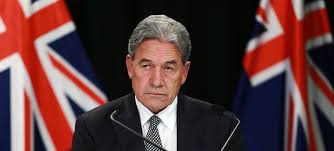by Brian de Lore
Published 24 April 2020
A massive groundswell of discontent has emerged from racing’s various stakeholders in the past week. It comes from the New Zealand Trainers Association, the New Zealand Racehorse Owners Federation and the ‘Next Generation of New Thoroughbred Racing’ who have all expressed a total frustration at being subjected to a continuance of decline through poor leadership.
The common theme coming strongly from all of these three groups is they have reached a tipping point and total frustration at an administration of racing which has failed them, and allowed the industry to further regress during a period that was designated by the Minister for racing’s revival.
It’s not far off two years since Messara completed his Messara Review of the New Zealand Industry which in a subsequent round of submissions was acceptable to 80 percent of the industry. And, despite Minister Peters at the launch of the Messara Review on August 30th,2018, saying all the right things and promising reform, we have seen only a continuance of the decline – mainly through RITA’s inability to put in place a workable structure for reform and recognise the people best equipped to operationalise it.
RITA has failed miserably and everyone knows it. Executive Chair Dean McKenzie in a relatively short time, has displayed a level of arrogance equalled only by his inability to perform the role of Executive Chair – a position that demanded a severe change of industry direction and a level of communication with racing’s stakeholders which has never looked like materialising.
This week’s outcry by the industry with a flurry of letters and OIA (Official Information Act) requests is supportive of that view
Harsh words but the truth! McKenzie neither has the skill-set or the leadership attributes to do the job – he needs to go and so does the board. This week’s outcry by the industry with a flurry of letters and OIA (Official Information Act) requests is supportive of that view. In the five years that the industry has gone from a plus $75 million equity to a $80 million debt ($45 million to the bank and the rest to pay up the bills) every appointment in racing’s administration has been a government one. Racing needs to take back control of itself. The Minister appointed McKenzie and his board but they are not representative of the requirements of the racing industry.
Thirty-one-year-old Michael Smith of Waterford Bloodstock was involved in two letters to the industry this week. The first on behalf of the group of almost 100 young New Zealanders known as the ‘Next Generation of New Zealand Thoroughbred Racing’ which had every name listed at the bottom and was sent to Minister Peters and copied to numerous others.
In part, it stated: “…we put our full weight, confidence, ambition and trust behind the Report and implore you and all relevant officials to support and implement the Messara Report on our behalf.
“As members of the next generation of New Zealand racing, we represent a wide variety of jobs, backgrounds, and geographic regions that are united by a shared passion for the industry. Racing is our life and livelihood, a part of the history and social fabric of this country, a significant employer and a key contributor to the overall economy. We are also a provider of an elite sporting product that Kiwis can be proud of the world over.
“…for too long ours has languished at the hands of those too short-sighted or ill-equipped to make the tough decisions and necessary changes.”
“The future belongs to those who prepare for it,” Smith’s letter continued, “and for too long ours has languished at the hands of those too short-sighted or ill-equipped to make the tough decisions and necessary changes.
“We are undoubtedly at a pivotal moment and acknowledge what this means for the future of our industry in general, and in particular for our generation which will ultimately prosper or decline based on the decisions you make now. While we know that change will not come easily, we are fully committed to implementing the recommendations of this Report and will play our part in their execution. If the reforms recommended by Mr Messara are not enacted soon, many of us will be forced to join other young New Zealanders already forging successful thoroughbred industry careers in Australia and beyond.”
The letter reverberated the group’s frustration in no uncertain terms and can be seen as a final-straw plea to the Minister to step up to the plate and make something positive happen for these young people before it’s too late.
Smith’s second letter was addressed to the Chair and Board of RITA, and was copied to 11 others including the Minister, John Messara and NZTR.
“…incredibly despite the support and clear direction of the Racing Minister to RITA, NZ Racing finds itself an even more dire position today than then.”
It began poignantly with: “I write to you as a frustrated stakeholder. We are nearly two years on from the Messara Report, one year on from RITA’s appointment (1.5 years if you include the time as MAC) and incredibly despite the support and clear direction of the Racing Minister to RITA, NZ Racing finds itself an even more dire position today than then.”
The letter didn’t hold back in asking RITA three questions: 1) Is the RITA Board a viable vehicle to deliver the changes necessary to revitalise racing in New Zealand? 2) Why has RITA veered so far from the direction of the Racing Minister to follow the Messara Report?, and 3) Where is the transparency regarding the status of RITA and actions to be taken?
On the first question, Smith elaborated with this comment: “In my opinion, it has to date, demonstrated that it is not viable. To borrow a phrase from the Racing Minister during his speech regarding the former NZRB at Claudelands, “I know a dead horse when I see one.” I was very hopeful upon the board’s inception but have been bitterly disappointed to date.
“The only difference between the RITA and the former NZRB as evidenced by its actions has been in name as since its commencement we have only experienced more of the same. Outside of the RITA Board Members, the same staff has stayed in place doing the same things that have led us to the place we are today (now $45m in debt and insolvent?). Aptitude, transparency, and appetite for the kind of restructure and change we need to cut the bloat, right the ship and get back on track seem to be nowhere in sight.”
Only a small part of Michael Smith’s letter is reproduced here but in summing up he also said: “To be honest I am beginning to think that RITA is working against the industry and not for it. The glimpses of the future I see for Thoroughbred Racing in New Zealand based on RITA’s actions to date without serious stakeholder intervention are that there will not be a ship left to steer in near future.”
President Bernard Hickey’s letter is a plethora of complaints around the activities and the direction taken by RITA.
Racehorse Owners Federation President Bernard Hickey’s letter to RITA was three pages and very comprehensive. It listed a plethora of complaints around the activities and the direction taken by RITA. It also requested documentation on eight aspects of the Agency’s financial dealings to provide information which it said would “…allow ‘Owners’ or the ‘Industry stakeholders’ to decide whether any formal Judicial process should be commenced to revoke Cabinet’s appointment of RITA upon non-compliance of due process and neglect to meet the requirements of the Minister’s expectations.”
The tone of the feeling at the Owners’ Federation is clearly evident in the above paragraph. The Trainers’ Association expressed a similar concern for themselves and their owners, in its letters stating: “Due to the uncertainty and lack of information coming from RITA the following questions need to be answered. To be fair and accountable to our owners who race horses at considerable expense, we need to assure them that putting their horses back into work is justified.”
“We need to be assured that RITA is in a position to support our participants going forward. We are aware of many trainers considering alternative careers, moving their operations overseas or being forced into premature retirement. The consequences of this are clearly a loss of horses, massive reductions in staff and racing industry support staff.”
The questions the Trainers’ asked revolved around solvency, certainty of distributions, reduction of costs, wage reductions, an inefficient RIU, joint venturing the TAB, Government security of racing, the Racing Reform Bill and clarity of ownership of the TAB.
The letter requested urgency of reply, and an email response was forthcoming within three hours. But it neither came from the Chair to which the Trainers’ letter was addressed nor did it answer any of the questions. It instead referred to its published Updates which it maintained contained the answers to the questions – typical of the RITA arrogant attitude and inability to communicate and display any goodwill to the stakeholders.
“This letter clearly shows the lack of respect for our Association and the stakeholders…”
The Trainers’ went back to its members in an email that said: “This letter clearly shows the lack of respect for our Association and the stakeholders within. We do not agree that our questions have been answered in their previous updates (that have previously been forwarded to you via this newsletter).
“It also does not provide any certainty around immediate or future stakes, or the liquidity of our industry. While we requested responses to our questions by midday Monday 27th April, prior to the move to Level 3, this has totally been disregarded.”
One of the current problems for the industry is the waiting for the result of the application for a supposed $80 million bail-out/loan. If it was approved, it would stave off insolvency but possibly extend the life of RITA which can be done if the Minister deems it necessary – he has that option under the Terms of Reference.
Racing doesn’t want RITA for an extended time period. It also cannot justify further debt – it’s possible the Government might approve a loan to RITA under similar conditions to which Air New Zealand was granted its COVID-19 loan at an interest rate of between eight and nine percent.
For that to happen would be a disaster for reasons that RITA would continue with the same business model, and the Government would require security which could only be the TAB – the only asset of any value. For that to happen, we might see all the Government and Ministerial controls that were present in the first reading of the Racing Reform Bill, not be changed per the February submissions, but be reinstated to a forever Government controlled industry doomed to fail in the long-term. That would be the final nail.
In everything stated above, you may have detected not one mention of NZTR (New Zealand Thoroughbred Racing). They supposedly represent the best interests of the stakeholders and all the participants of the thoroughbred code – but how well do they do it – poorly I would suggest. They are a pussy-cat organisation that needs to go eat some iron bars, harden-up, bang a few heads and turn into tigers.
Why hasn’t NZTR developed some steel and demanded more from the Minister?
Why hasn’t NZTR developed some steel and demanded more from the Minister? NZTR told The Optimist a week ago they are not permitted to deal directly with the Minister and all communiques must go through RITA or the Minister’s office. That’s rubbish, and it should be a cue to them to deal directly and ignore the RITA directives and develop a bulldozer mentality – the board table has never worked for them.
The sector groups that have surfaced this week are showing NZTR up. In its ‘Proposed programme for a return to racing’ news release on April 21st, NZTR said the following:
“We can’t confirm industry funding or stakes levels until we get more information from RITA on its 20/21 budget. We felt it was important that the industry get some draft racing dates so we can start getting horses ready for racing.”
Yes, we know, so what is RITA doing about it? Last year RITA’s budget came out in November so why would you even contemplate getting it this year in April. RITA hasn’t yet announced its half-year result, which had a final date of January 31st. RITA missed budget by $35 million last year, so it’s budget is irrelevant. RITA is broke so what level of stakes do you expect? These are the real questions to be addressed.
An estimate I have seen based on the back of an envelope calculation is stakes may have to be reduced by 40 to 50 percent on 2019 levels (economically unsound prospect for any owner).
An estimate I have seen based on the back of an envelope calculation is stakes may have to be reduced by 40 to 50 percent on 2019 levels (economically unsound prospect for any owner).
The same news item also stated: “These are incredibly challenging times and we must focus on what is best for thoroughbred racing and what will get the most horses back racing as quickly as possible.”
Coming back quickly in the middle of winter may not be what’s best for thoroughbred racing. How many horses and numbers of races will any given meeting attract, and to get back quickly for the sake of getting back quickly (in lieu of a cunning plan) isn’t going to suit too many owners who are up for $3,000/month for a horse in full work and two to three months to get a horse race fit ($6,000 to $9,000 outlay).
As usual, the owners will bear the full brunt of the cost for a product that could make ‘mediocre’ racing look like the new ‘impressive.’
…owners who pay for the show, along with punters who provide the stakes through betting, are the two most important yet least considered groups…
Racehorse owners who pay for the show, along with punters who provide the stakes through betting, are the two most important yet least considered groups in this business known as the racing industry.
The solution: Bring back one of the world’s most respected racing administrators in John Messara to coordinate the recruitment of a task force to fix this problem. De-commission RITA and allow Messara to complete the job he was asked to begin two years ago – exactly two years ago on 27th April 2018 I wrote a story entitled ‘Messara Report will be the job only half done.’ Nothing has changed in the ensuing 24 months.



